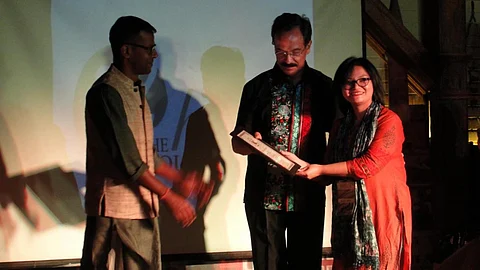
- Topics
- Feature
- Opportunities & Events
- About
- Hindi Portal
- Data
- Topics
- Feature
- Opportunities & Events
- About
- Hindi Portal
- Data

Minket Lepcha always felt close to nature and the environment since her childhood, thanks to her upbringing in the picturesque Darjeeling. Though she had spent many years in Delhi, studying and working in corporate firms, her interest in community development, environment and culture brought her back to her home town.
Leaving her corporate life in Delhi behind, she started teaching at a school in Darjeeling. In teaching, she finds an opportunity to influence and steer the minds of future thinkers towards the environment and conservation. It’s this passion for nature and conservation that motivated her to make a film on river Teesta.
She was recently awarded Young Green Filmmaker 2016 at the fourth edition of Woodpecker International Film Festival, India's premier competitive film festival that focuses on issue-based cinema, held at Sirifort Auditorium in New Delhi. The Voices of Teesta is a 41-minute film which portrays the close relationship the various ethnic communities of Sikkim and West Bengal maintain with river Teesta. The film tries to delineate the impact of various infrastructural developments accomplished on the course of the river and its implications on different communities living around it. The film also captures the unheard voices of local people affected by these developments.
India Water Portal caught up with her to know more about her experience making this film.
Teesta is the lifeline of the people of Sikkim and West Bengal. The rampant development around Teesta has affected not only the eco system, but also the socio-cultural life of the people. Back in 2008, when I met the dam-affected citizens of Teesta in New Delhi for their anti–dam protest, I realised that there is a need to understand the environmental and cultural issues around Teesta very carefully. I wanted to share the voices and concerns of those people living around Teesta through my film. Having said that, my effort is to create awareness whenever and wherever I get an opportunity to talk about the environment in general.
A lot of changes have happened around Teesta. In the past few decades, Teesta has seen a surge of infrastructure projects mushrooming on its bed, such as hydropower projects, pharmaceutical companies and other development projects. These projects have affected the river and its environment to a great extent.
During my various interviews with people living around the Teesta, a lot of stories--ranging from issues related to compensation, livelihood and environmental impacts--came to light. There has been a visible impact on the environment around Teesta in the form of landslides and depletion of medicinal plants. Farmers have been complaining about the areas near the hydro project sinking and the environmental damages caused by drilling the mountains.
Due to TLDP III and TLDP IV hydropower projects on Teesta, the livelihoods of thousands of people related to rafting and quarrying were affected.
Most of the people affected by hydropower projects are dissatisfied with the settlement amount paid to them. Thousands of displaced people are looking for jobs as labourers in the hydropower companies. Many have not been rehabilitated. There were cases where people were displaced more than four times.
Upstream riverine communities have been trying their best to hold on to their cultural practices and retain the ‘purity’ of their place, but the downstream communities are now more concerned about their livelihood than anything. The people downstream say their cultural practices around Teesta river have changed over a period of time. Many rituals that were once performed on the bank of river Teesta, like the huge gathering of communities for Mage Sankranti (January) and the celebration at Triveni, have lost their glory. People now prefer to perform rituals on small rivulets than on big banks.
The farmers complain that there is a decrease in their agricultural production. The people say rafting as a sport has been affected because of the dams across Teesta that slow the water currents and the quarry workers are complaining about lack of work. During the shooting of the documentary, I found out that the TLDP hydro project III- Kalijhora was about to begin and the quarry workers in the area were worried about their livelihood because they now have to find a new place for quarrying.
No, I don't think so; even if there is one, it's just on papers. According to the people there, the critical issues like compensation, rehabilitation, livelihood opportunities, necessary facilities, etc were never discussed by the government with them to avoid any resistance from the citizens.
There is a need to unite people to save Teesta. Their voices need to be heard!